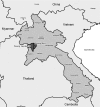Reassortant highly pathogenic influenza A(H5N6) virus in Laos
- PMID: 25695754
- PMCID: PMC4344285
- DOI: 10.3201/eid2103.141488
Reassortant highly pathogenic influenza A(H5N6) virus in Laos
Abstract
In March 2014, avian influenza in poultry in Laos was caused by an emergent influenza A(H5N6) virus. Genetic analysis indicated that the virus had originated from reassortment of influenza A(H5N1) clade 2.3.2.1b, variant clade 2.3.4, and influenza A(H6N6) viruses that circulate broadly in duck populations in southern and eastern China.
Figures


References
-
- Food and Agriculture Organization of the United Nations. Approaches to controlling, preventing and eliminating H5N1 highly pathogenic avian influenza in endemic countries. Animal Production and Health Paper No 171. Rome: The Organization; 2011.
-
- Boltz DA, Douangngeun B, Phommachanh P, Sinthasak S, Mondry R, Obert C, et al. Emergence of H5N1 avian influenza viruses with reduced sensitivity to neuraminidase inhibitors and novel reassortants in Lao People’s Democratic Republic. J Gen Virol. 2010;91:949–59. 10.1099/vir.0.017459-0 - DOI - PMC - PubMed
-
- World Organisation for Animal Health. Update on highly pathogenic avian influenza in animals (type H5 and H7), 2014. [cited 2014 Aug 25]. http://www.oie.int/animal-health-in-the-world/update-on-avian-influenza/...
Publication types
MeSH terms
Substances
LinkOut - more resources
Full Text Sources
Other Literature Sources
Medical

